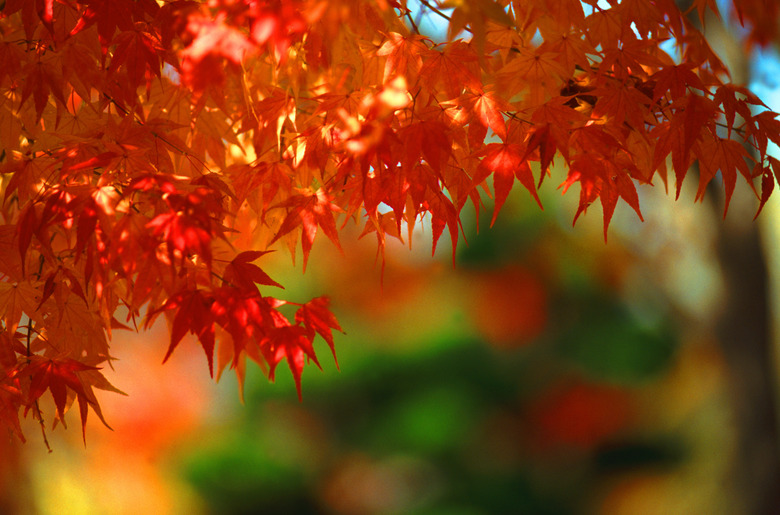Why Are My Plant Leaves Turning Red During Summer?
Red foliage enhances desirability in some ornamental plants, but when green summer leaves turn red unexpectedly, color can be cause for concern. The same red and purple pigments behind similar colors in flowers, fruits and fall foliage show up in plants under stress. Sugars that normally move freely through plants produce the pigments, known as anthocyanins, when something causes sugars to build up. Several factors can cause this unwelcome redness in summer leaves.
Examining Soil Phosphorus
When soil lacks sufficient phosphorus, sugars build up and red pigments develop in some plants. Phosphorus moves to new leaves when shortages exist, so older, lower leaves show redness first. Phosphorus-deficient plants mature slowly, showing stunted growth and fewer flowers and fruit. Heavy crop rotations often cause phosphorus deficiencies in agricultural settings, but this doesn't happen often in home gardens. Instead, other factors may prevent plants from absorbing phosphorus — even when it's abundant in soil. Never add phosphorus unless a soil test confirms the need; unnecessary use damages plants and the environment. If needed, bone meal is a slow-release, phosphorus-only, 0-10-0 fertilizer. One cup gently worked into the soil around a shrub's base is sufficient. Phosphorus doesn't move through soil, so apply it directly to the area where the roots of affected plants lie.
Checking on Soil pH
Phosphorus is more sensitive to soil pH than any other essential plant nutrient. When soil pH gets too far from the 7.0 neutral zone, interaction between elements makes phosphorus insoluble and unavailable for plants to absorb. Plants that need more phosphorus than soil pH allows often get red leaves. With phosphorus, this happens at both high and low pH levels. For example, soil pH below 5.5 limits available phosphorus by as much as 30 percent. A soil test reveals pH and recommends amendments specific to your soil type to change pH without adding unnecessary nutrients. Wood fireplace ashes spread in a thin layer over winter and worked into spring soil raise pH without adding extra phosphorus.
Considering Cultural Problems
Improper watering disrupts the movement of sugars and phosphorus and stimulates red pigments. This occurs with overwatering and underwatering. Overly dry conditions limit available moisture to move nutrients to leaves. In overly wet conditions, oxygen needed for healthy root activity gets displaced and plants can't take up the water and nutrients they need. Without moisture and phosphorus, sugars build up and red leaves appear. Mechanical injuries from weed trimmers and other tools also cause redness in leaves, as does damage from herbicides and insects. Examine foliage closely for signs of pests. Handpick offenders from plants or wash them away with a strong hose blast.
Addressing Environmental Issues
Fluctuations in the soil and air around plants upset nutrients and cause red pigments. Cool spring air and cold soil often produces red and purple foliage tints. In summer, extremes of high heat followed by cooler temperatures cause nutrient imbalances. Anything that dehydrates roots and plant tissues can lead to red leaves. Poor soil drainage and compacted soil, often prevalent in urban areas, limit the flow of necessary water and nutrients between roots and leaves. High soil salts draw water away from plant roots and create droughtlike conditions that cause red leaves as surely as true drought. Occasional heavy watering helps move soil salts through soil and away from sensitive plant roots.
References
- Washington State University Puyallup Research and Extension Center: The Myth of Red Leaves
- Clemson Cooperative Extension: Color Changes in Autumn Leaves
- Florida Industrial and Phosphate Research Institute: Phosphate Primer
- Nutrient Stewardship: Soil pH and the Availability of Plant Nutrients
- Mississippi State University: Corn in Mississippi: Why Is My Young Corn Stunted and Purple?
- Clemson Cooperative Extension: Changing the pH of Your soil
